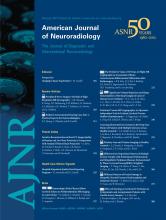W.J. Van Rooij describes the single-institution management strategy and outcome of active intervention of 86 cavernous sinus segment (CS) ICA aneurysms in the article entitled “Endovascular Treatment of Cavernous Sinus Aneurysms.”1 Twenty-one of the aneurysms treated were asymptomatic, while 56 presented with cranial neuropathy, 8 with a carotid cavernous fistula, and 1 with subarachnoid hemorrhage.
Treatment consisted of endosaccular coiling in 31 (36%) of the aneurysms, while parent vessel occlusion was performed in 50 (64%), with procedures done following bypass surgery because of test balloon occlusion intolerance.
Treatment-related neurologic complications did not occur in the group that underwent endosaccular coiling, but 2 patients (4%) developed transient neurologic deficits following parent vessel occlusion, while 1 patient (2%) developed a permanent neurologic deficit as the result of the treatment, for a total of 6% periprocedural neurologic sequel. There was no mortality.
All 8 cavernous sinus fistulas were closed with coils. In 52 of 56 (93%) patients presenting with symptoms of mass effect, symptoms were alleviated (n = 23) or improved (n = 29) at follow-up, and 34 of 50 aneurysms (68%) were substantially decreased or completely obliterated.
This article brings to our attention once again the frequent modern management dilemma of knowing whether to provide treatment for a condition of which we do not know the natural history. The prevalence of CS ICA aneurysms in the general population is not exactly known, and certainly we have all seen, in the past few years, many more such aneurysms, incidentally discovered at the time of noninvasive imaging performed for unrelated symptoms. Very few natural history studies have been performed, and most included small numbers of patients.2⇓–4
Linskey et al2 prospectively followed 20 CS ICA aneurysms for an average of 2.4 years and demonstrated that only 1 of 10 asymptomatic lesions became symptomatic to the point of requiring treatment, while 4 of the symptomatic lesions became asymptomatic in time. Kupersmith et al3 prospectively followed 12 asymptomatic CS ICA aneurysms, and all remained asymptomatic with time. On the other hand, Goldenberg-Cohen et al4 reported that among 10 asymptomatic patients, 7 worsened on long-term follow-up.
It is unfortunate that in the current series, 19 patients were excluded because no active treatment was performed and unfortunately no follow-up on these patients was available, which could have provided some much-needed insight into the natural history of this disorder.1
In addition, there continues to be a tendency to lump all aneurysms together without making a proper distinction between their various etiologies, which almost certainly will lead to different natural histories (dissecting, dysplastic, arteriosclerotic, iatrogenic pseudoaneurysm, and so forth). This lack of detailed information remains an obstacle to the understanding of previously published literature and its implications for management. Consequently, a properly conducted natural history study would be tremendously helpful and is long overdue.
The indication for active treatment of asymptomatic CS ICA aneurysms is, therefore, questionable, and any decision to treat should be carefully considered in view of our very limited knowledge of their natural history and the small but definite immediate potential risk associated with their treatment. There is little scientific evidence to support treatment of an asymptomatic CS ICA aneurysm, irrespective of size or age. There is certainly no indication for treatment if the aneurysm is small and the patient is in the elderly age group.
The indication for active treatment of symptomatic CS ICA aneurysms is questionable when neurologic symptoms are stable and well-tolerated and the patient is in the older age group. On the other hand, active intervention is well-accepted for those patients with CS ICA aneurysms who present with progressive neurologic symptoms, pain syndromes that are not clinically tolerated, or aneurysms associated with rupture into the adjacent cavernous sinus, sphenoid sinus, or subarachnoid space.
With respect to the treatment choice, several reports in the literature as well as the current study have documented variable outcome results as well as procedural risks.1,5⇓⇓–8 Endosaccular coiling of the aneurysm alone was associated with a cure rate on follow-up of approximately 80% with no associated neurologic deficits in the meta-analysis study of 316 CS ICA aneurysms,6 while parent vessel occlusion resulted in a 98% cure rate, but the procedure-related neurologic deficits were 5%. Stent-assisted coiling resulted in a 75% cure rate on follow-up and was associated with a 3.5% risk for neurologic deficits in a recent series of 113 patients with CS ICA aneurysms, 47% of which were treated by stent placement and coiling.8 The experience with flow-diverting stents under these circumstances is still evolving, and while conceptually intriguing, the early results show excellent ability to exclude the aneurysm lumen but unpredictable outcome with respect to mass effect reduction and neurologic improvement.
As new treatment options become available, the risk-management strategy will need to include a consideration of which type of treatment (parent vessel occlusion, coiling, stent placement, flow-diverting stent, and so forth) would be most efficient for alleviating symptoms at the lowest possible associated risk.
As is the case with intradural aneurysms, our focus has been mostly on fixing (obliterating) the lumen of the aneurysm, while a more recent investigation by Krings et al8 suggests that vessel wall disorders may be the primary pathology responsible for luminal enlargement, at least in certain aneurysms, and that modern imaging can be used to distinguish various vessel wall pathologies and to establish whether the aneurysm wall is inactive and stable versus active and vulnerable. This distinction may also help us to be more precise in selecting which patients with CS ICA aneurysms should be treated.
As the current study1 documents, it is certainly interesting to observe the strong female sex predominance of CS ICA aneurysms, which is similar to the strong female preponderance of dural arteriovenous shunts in the same region, which appears to be more than a coincidence and would benefit from further targeted research.
References
- © 2012 by American Journal of Neuroradiology












